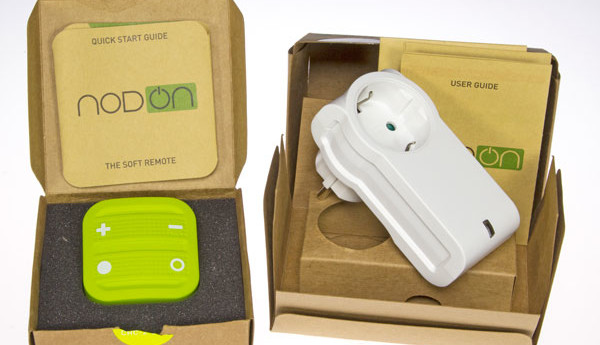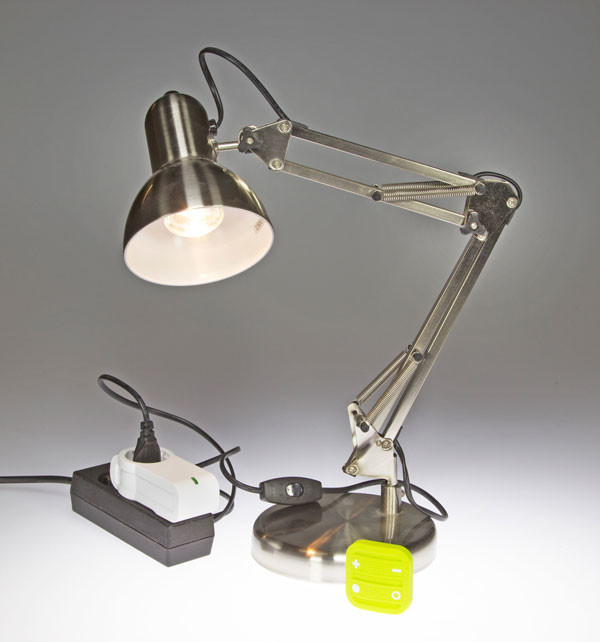Home Automation for beginners
December 22, 2015
on
on

Admiring all the latest TVs, phones and appliances on show at the last IFA consumer exhibition in Berlin this year I ended up in the TecWatch hall where all sorts of IoT/home automation innovations were on show. Amongst the start-ups the French company NodOn were showcasing there system of radio modules. A few weeks after my visit a package containing an example of their starter equipment dropped onto my desk. Inside was a remote controller unit (retailing at around 40 Euros) together with a radio-controlled switched outlet (SmartPlug at around 45 Euros). The basic concept isn’t new and you can buy similar remotely-controlled sockets at the corner hardware store. The grass-green color of the unit that arrived is certainly a matter of taste but it’s also available in a range of colors.

The remote controller unit fitted with four pushbuttons is protected by a soft plastic cover, making it resistance to dust and water spray. The quality of construction is very good. The plug-in switched socket is also well designed although the transparent cap over the indicator LED seemed a little loose. I now delved into the ‘Quick start guide’ to find out what all the buttons do. Aha, so the switched socket is fitted with a red/green LED with a transparent cap which also functions as a push button. So the loose cap isn’t a Bug but a Feature. It allows you to manually switch the socket on and off. The LED also indicates when it’s in ‘learn’ mode, pairing with a remote control unit. Hold the push button down for two seconds and the LED turns red indicating learn and now when a button on a remote controller is pressed the LED blinks green to indicate it has been paired. The switch unit can now be controlled on and off by pressing ‘+’ an ‘-’ respectively on the remote controller.
According to the technical data it can switch a maximum of 3000 W (with a resistive load). The unit is controllable throughout a typical domestic installation easily achieving 10 m range through walls but I don’t have a living space big enough to test the quoted 30 m line-of-sight range. The four keys provide an on/off function for two channels. The remote controller unit can be carried in the hand or attached using its magnetic base to a surface. The grip was a little marginal on vertical surfaces and would have benefitted from a stronger magnet. The push buttons under the plastic cover are a little stiff to operate. The NodOn web site indicates that the unit actually harvests energy from the mechanical action of pressing the buttons to send the signal. This feature singles the unit out from the standard remote controlled socket you can buy at the corner hardware store. The system does not rely on batteries at all so it scores a big tick in the green box. The only thing worthy of note here is the amount of pressure required to operate the push button may be too much for a small child (which may even be a positive feature for some installations).
A big advantage of this system is its use of EnOcean radio protocol on 868 MHz which is a widely adopted standard for domestic controllers. This makes it easy to expand the system with more switch units form the same or even other manufacturers. Other sensors in the range include a window-open detector and a self-powered smartcard reader/switch. The window sensor can be programmed, during the learn procedure, to trigger on opening or closing. The system setup is quite intuitive for a beginner: there is no need to enter codes or hook up to a PC or other programming device. It is not be necessary, but the facility is available to connect via a home automation EnOcean gateway from where the remote controlled outlet can be controlled. More information is available from the manufacturer: NodOn

The remote controller unit fitted with four pushbuttons is protected by a soft plastic cover, making it resistance to dust and water spray. The quality of construction is very good. The plug-in switched socket is also well designed although the transparent cap over the indicator LED seemed a little loose. I now delved into the ‘Quick start guide’ to find out what all the buttons do. Aha, so the switched socket is fitted with a red/green LED with a transparent cap which also functions as a push button. So the loose cap isn’t a Bug but a Feature. It allows you to manually switch the socket on and off. The LED also indicates when it’s in ‘learn’ mode, pairing with a remote control unit. Hold the push button down for two seconds and the LED turns red indicating learn and now when a button on a remote controller is pressed the LED blinks green to indicate it has been paired. The switch unit can now be controlled on and off by pressing ‘+’ an ‘-’ respectively on the remote controller.
According to the technical data it can switch a maximum of 3000 W (with a resistive load). The unit is controllable throughout a typical domestic installation easily achieving 10 m range through walls but I don’t have a living space big enough to test the quoted 30 m line-of-sight range. The four keys provide an on/off function for two channels. The remote controller unit can be carried in the hand or attached using its magnetic base to a surface. The grip was a little marginal on vertical surfaces and would have benefitted from a stronger magnet. The push buttons under the plastic cover are a little stiff to operate. The NodOn web site indicates that the unit actually harvests energy from the mechanical action of pressing the buttons to send the signal. This feature singles the unit out from the standard remote controlled socket you can buy at the corner hardware store. The system does not rely on batteries at all so it scores a big tick in the green box. The only thing worthy of note here is the amount of pressure required to operate the push button may be too much for a small child (which may even be a positive feature for some installations).
A big advantage of this system is its use of EnOcean radio protocol on 868 MHz which is a widely adopted standard for domestic controllers. This makes it easy to expand the system with more switch units form the same or even other manufacturers. Other sensors in the range include a window-open detector and a self-powered smartcard reader/switch. The window sensor can be programmed, during the learn procedure, to trigger on opening or closing. The system setup is quite intuitive for a beginner: there is no need to enter codes or hook up to a PC or other programming device. It is not be necessary, but the facility is available to connect via a home automation EnOcean gateway from where the remote controlled outlet can be controlled. More information is available from the manufacturer: NodOn
Read full article
Hide full article



Discussion (0 comments)